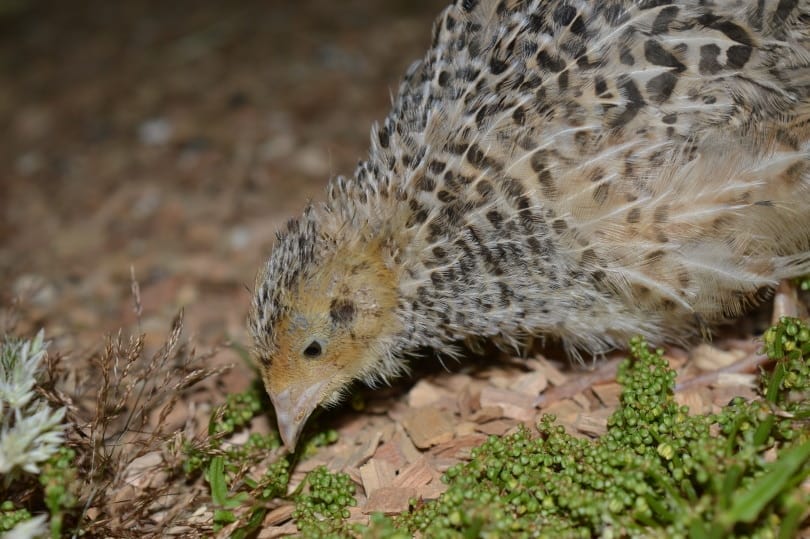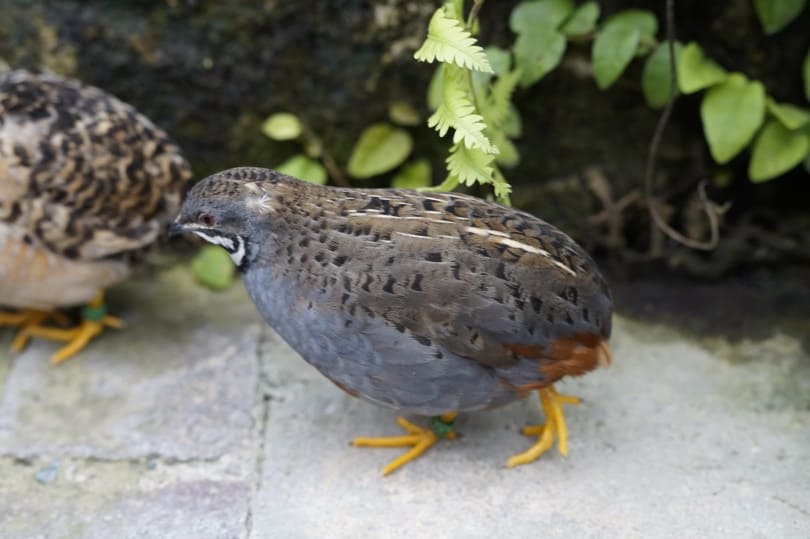The beautiful King quail is an ornamental bird with colorful feathers. They are also called blue-breasted quail, Asian blue quail, or Chinese painted quail. Even though they’re capable of flying if they have to, they prefer to spend the majority of their lives on the ground. They live in the wild throughout Southeast Asia and Oceania countries. These small birds are kept as pets and are found in zoos around the world.
While they are naturally vibrant birds, selective breeding in captivity is done to make them even more colorful.

Quick Facts about King Quail

| Breed Name: | King |
| Place of Origin: | Asia |
| Uses: | Ornamental pets, hobby |
| Male Quail Size: | 4.7–5.5 inches |
| Female Quail Size: | 4.7–5.5 inches (usually bigger than males) |
| Color: | Blue, brown, silver, black, red, white |
| Lifespan: | 3–6 years in the wild; 13 years in captivity |
| Climate Tolerance: | Warm |
| Care Level: | Beginner |
| Clutch Size: | 5–13 eggs |
| Flying Ability: | Short distances |
King Quail Origins
King quail are found from India to China, Southeast Asia, the Philippines, Indonesia, New Guinea, and northern and eastern Australia. They are a species of Old World quail belonging to the family Phasianidae. They are sometimes called buttonquails, but buttonquails, although similar in appearance, are not from the same family and are only distantly related to King quail.
King Quail Characteristics
King quail are small, rounded birds with orange legs and feet. They have black beaks, reddish-brown eyes, and short, dark tails. Wild male King quail have a bluish-grey chest. Their bellies are red or rust. White patches with black edges run down their throats. Mottled brown and black back and tail feathers are usually seen.
Female King quail are brown with silver chests. They also have mottled brown and black tail feathers. They don’t have blue feathers.
King quail can blend in well with their surroundings and know how to avoid predators. Since they prefer to live on the ground, they’re adept at hiding from danger. They can fly, if necessary, though they won’t get high off the ground. They can only fly for short distances.
Taming King quail can be done with persistence and a great deal of patience, but they don’t often like human touch. They respond positively to loving care and attention, though. They’re quiet, active birds that can be entertaining to watch. They can also run quite quickly, especially if they feel that they’re in danger. They can be shy with people and prefer hiding spaces on the ground in their enclosures to help them feel safe. King quail are social birds that need other birds around them to thrive. One male to two female King quail is the recommended grouping.
Uses
It’s possible to use King quail for their eggs and meat, but they don’t produce significant amounts of either. Mainly, these birds are kept today as ornamental pets that have the potential to become tame. Young children shouldn’t handle the birds unless they know how to do so safely. King quail can easily become injured due to their small size.
Hobbyists enjoy adding King quail to their aviaries. Since they are ground-dwelling birds, they keep the floor of the aviary clean by eating dropped seeds. They’re also easy to care for and get along well with other birds.
Appearance & Varieties
In captivity, different color combinations and mutations have occurred through selective breeding. Females are never red or blue. They are often duller in appearance than the males. This is a common way that breeders tell the sexes apart.
Color varieties of King quail include:
- Red-breasted
- Bluefaced
- Silver
- White
- Golden pearl
- Cinnamon
- Tuxedo pied
- White-winged pied
- Splash pied
The intentional breeding of these color varieties with each other leads to many other color combinations. The most widely known is silver, followed by white and mottled silver-grey. Splash pied is the presence of white patches like the bird was splashed with white paint. Combining the different color patterns means there’s no limit to the color varieties of the King quail.
Population/Distribution/Habitat
King quail in the wild are declining. Their population size is only speculated, but the loss of the quail’s natural habitat is a contributing factor to this decline. King quail live on the ground in dense vegetation, such as swamps, shrubland, and grasslands. Fires, agricultural expansion, and urban development have all led to the loss of the King quail’s habitat.
This small, ground-dwelling bird is distributed from India to China and from New Guinea to northern, eastern, and southern Australia.

Are King Quail Good for Small-Scale Farming?
King quails are not practical choices for small-scale farming. They are tiny birds, reaching only 5.5 inches in length and weighing under 2 ounces. To use them for egg or meat production, the number of birds needed would be difficult to house at one time. King quail eggs are edible and can be consumed, but they’re small. They are creamy brown and weigh only 0.2 ounces. An average chicken egg weighs 1.7 ounces. Many more King quail eggs would be needed for substantial small-scale farming. These birds are mainly kept as pets or as colorful additions to aviaries by aviculturists.
That said, King quail are hardy birds and can be kept by novice bird owners. Small children shouldn’t handle them, though, in case of accidental injury due to the bird’s size. Since they prefer to live on the ground to search for food, King quail will keep the bottom of an aviary clear of any dropped seeds.
King quail lay eggs, but their small bodies and resulting small eggs don’t make them suitable for small-scale farming. Their eggs can be eaten, but more may be needed to meet demand.
If you’re looking for a bright, calm, beautiful bird to add to your aviary, the King quail will make excellent additions. They need company to thrive because of their social nature with others of their species. While it’s tempting to want to pet these small birds, many don’t like to be handled by humans. In some cases, taming them is possible with persistence.
Featured Image Credit: Piqsels
